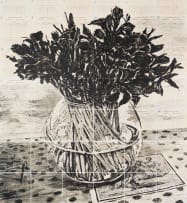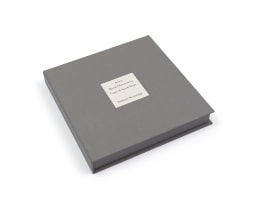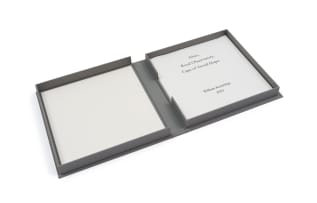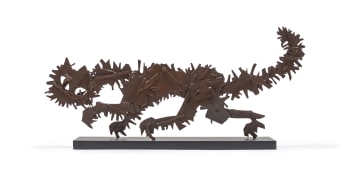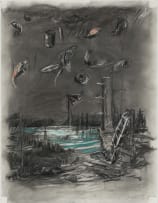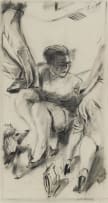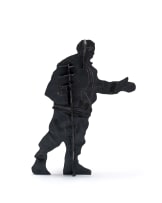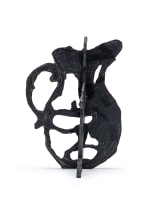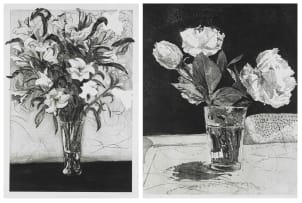Irises, Royal Observatory, Cape of Good Hope
William Kentridge
Incl. Buyer's Premium & VAT
About this Item
signed, numbered 9/24 in red conté and embossed with The Artists' Press chopmark in the margin
Notes
The present lot is from an edition of 24.
William Kentridge's debut exhibition in 1979 was largely composed of monoprints. Over the ensuing decades, as his media has proliferated and career blossomed, printmaking, rather than taking a backseat, has remained a "very central part" of his studio practice.1 Kentridge has worked with a number of respected master printers, including Mark Attwood of The Artists' Press in White River, Mpumalanga. This ambitious lithograph, printed from aluminium plates in six runs, depicts a German bearded iris. Kentridge rendered the flower using charcoal, India ink, and black pencil on ball grained film.
The underlying text of the individual panels making up this composition reproduces a 1947 astronomers' logbook from the Royal Observatory in Cape Town (now the South African Astronomical Observatory). The logbook was scanned, exposed onto a plate and then hand-printed. The individual panels were stained with lightfast watercolour pigment and then pasted onto 100% cotton fabric using archival wheat starch adhesive. There is some India ink hand-painted detail in the panel gaps on the iris flower section of the print. Attwood was assisted by edition printer Jacky Tsila and printing assistant Hazel Sibande.
Aside from the formal challenge and pleasure of rendering flowers, Kentridge has long been fascinated by Édouard Manet's capacity to move between flowers and politics, the studio and the world. Like Manet, whose five versions of The Execution of Emperor Maximilian (1867-69) drew strongly on Goya, Kentridge's lithograph explicitly gestures to the influence of Goya. The bowl of irises rests on top of Plate 39 from Goya's Disaster of War series (1810-20). Goya's etching portrays three figures strung up on a tree trunk. Kentridge's depictions of irises, peonies, and lilies skilfully synthesise his formal and intellectual interests. They are highly collectable. Strauss & Co sold Kentridge's 1991 drawing of a Dutch iris for R4.2 million in 2019.
1. William Kentridge (2015), Interview with Cécile Godefroy and Vérane Tasseau for Cahiers d'Art Special Issue, Picasso: In the Studio. London, Thames & Hudson, WK studio archive.
After studying Political Science at Wits in the late 1970s William Kentridge studied the art of mime in Paris in the early 1980s. He now continually combines these interests in his art. His phenomenal drawing skills were sharpened while studying at the Johannesburg Art Foundation and, in the numerous stop-frame video animations of the 1990s and the large-scale installations of the early twenty-first century, he dramatically renders the effects of colonialism on the oppressed. Regularly mounting major exhibitions and dramatic productions, locally and internationally, he is the recipient of numerous local and international awards and is the true embodiment of Contemporary African Art.

